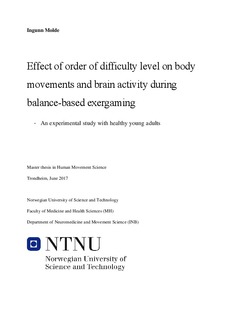| dc.description.abstract | Background: Exergaming refers to exercise through videogames, and is increasingly used to train both physical and cognitive functions. Increasing the difficulty level of the game is often a natural part of gaming, and changing the difficulty level, either by increasing or decreasing the difficulty, is one of the main advantages of exergaming. However, there is limited research on whether it matters if you increase or decrease the difficulty level with regards to player’s body movement and brain activity during game play.
Aim: To examine whether it matters which difficulty level you start with on player’s body movements and brain activity during exergaming.
Methods: Twenty-four healthy young adults (12 men, 12 woman, mean age 24.5±.4yrs) played a puzzle game at two difficulty levels, one with one puzzle piece (No Choice), and one choosing between two pieces (Choice). Puzzle pieces were chosen by mediolateral body movements to the appropriate side. Brain activity in all conditions was recorded using a 64-channel EEG system and EOG electrodes (SynAmps, RT; Compumedics Neuroscan, US), and mean spectral power was calculated for theta activity (4-7Hz) in a predefined frontal region of interest (F3,F1,Fz;F2,F4). Ground reaction forces from two Kistler force plates were recorded at 100 Hz, and used to calculate amplitude, area, velocity, and smoothness (calculated as jerk) of the centre of pressure traces (CoP). Statistical analysis consisted of independent samples t-tests and two way repeated measures ANOVAs.
Results: The group with Increasing difficulty level had on average a significantly larger CoP area, compared to the Decreasing Difficulty Group (p=.020). The Increasing Difficulty Group also had on average a significantly larger CoP mediolateral amplitude compared to the Decreasing Difficulty Group (p.=.035). The same results were found on the frontal theta activity, the Increasing Difficulty Group also had on average higher frontal theta activity, compared to the Decreasing Difficulty Group (p=.016). There were no significant difference between the two groups on any of the other variables (CoP velocity and CoP jerk >.05).
Conclusion: The Increasing Difficulty Group had on average a larger CoP amplitude, CoP area and higher theta activity, compared to the Decreasing Difficulty Group. These results might point in the direction of playing with an increased difficulty level. Future research should investigate a flexible difficulty level and ask about information of previous experience with exergaming and enjoyment of the game. | nb_NO |
